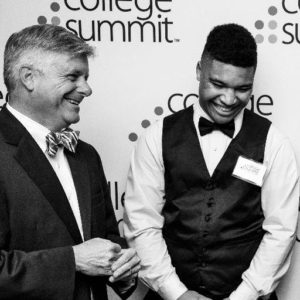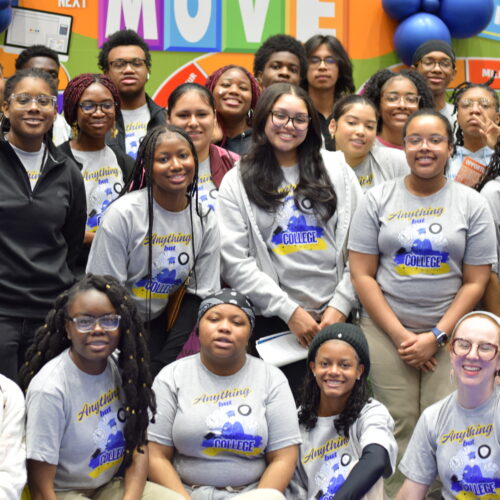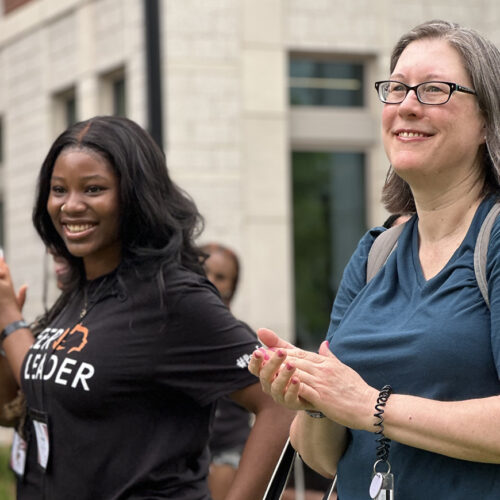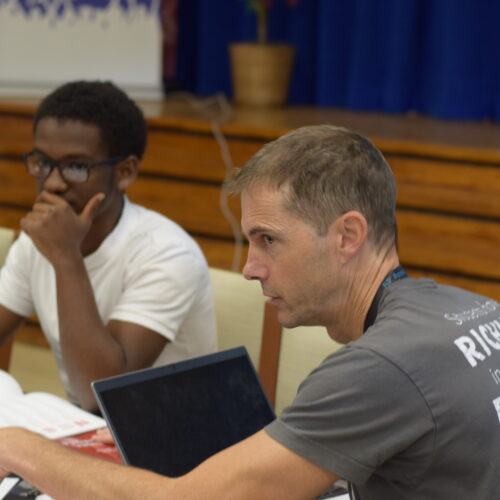
This past summer, PeerForward trained 110 teams of high school juniors and seniors from public schools from around the country to coach the rest of their classmates to navigate their way to higher education. They do this by creating teams at their school and driving, under the guidance of a faculty member and a PeerForward coach, three campaigns in which all seniors submit their FAFSA forms early; all seniors submit more than three post-secondary applications; and all students in a school make a plan for their life linking their career aspirations to post-secondary education and high school graduation requirements.
The model relies on peer influence, measurement and community organizing to achieve its intended impact to increase the number of young people from low-income communities who enroll and persist through higher education. It is a high leverage strategy. The 110 PeerForward Peer Leader teams this summer will be disseminating college knowledge and coaching to 100,000 high school students.
There is one more element that drives and lubricates this work: Compassion. The philosopher Martha Nussbaum distinguishes “empathy” from “compassion.” Empathy, Nussbaum argues, is the ability to reconstruct another’s experience without judgment about the value or nature of the experience, i.e. whether it is good or bad or paltry or happy or sad. (Upheavals of Thought, 302). Compassion is more complex, involving three elements: (1) a judgment that someone is suffering; (2) the belief that the person is innocent, that is, they did not bring about their own suffering; (3) the understanding that we have what Nussbaum terms a “related vulnerability” in that we identify with the person because the same misfortune could befall us someday thus connecting us to the person as we share with them a common set of values and understandings of what is good and just. Clearly, we need the power of empathy to be compassionate. Nussbaum makes the point, though, that when the three elements of compassion are in place, their conjunction is “very likely to lead to action.” (335)
Though PeerForward Peer Leaders are relentlessly focused on measurable outcomes, they achieve those outcomes precisely because they possess the three elements of compassion and, through their training in storytelling and listening, are able to empathically imagine the situation of their classmates. They know that usually less than 50% of their classmates graduate from high school and less than 50% of these graduates enroll in higher education and only about 10% of them will finish a 4-year degree. They know that a post-secondary degree is the gateway to economic independence, personal fulfillment and a longer, healthier life. They know that the status quo is not the fault of their classmates and friends but are accidents of their zip code, the result of centuries of injustice. And they know that they too are vulnerable. Thus, they are propelled to act – to return to their communities to share the Promethean fire of college knowledge and to, in the words of the peer influence scholar, Robert Crosnoe, “instrumentally assist” their classmates to graduate and matriculate in order to fulfill their lives.
Compassion is, therefore, not just a disposition; it is an action. Henry Sidgwick (Methods of Ethics, 1874) argued that it is in the services we do for others that we exercise morality; possessing merely a benevolent or loving disposition without action is not in and of itself moral. In a footnote, which I furiously underlined when I first read it 30 years ago knowing somehow it might be relevant at some point in my life, Sidgwick gets to the heart of the matter: “It must be admitted that the more the benevolent impulse is combined with the habit of considering the complex consequences of different courses of action that may be presented as alternatives, and comparing the amounts of happiness to others respectively resulting from them, the more good, ceteris paribus, is likely to be caused by it on the whole. And so far as there seems to be a certain natural incompatibility between this habit of calculation and comparison and the spontaneous fervor of kindly impulse, Common Sense is somewhat puzzled which to prefer; and takes refuge in an ideal that transcends this incompatibility and includes the two.” (244, 7th ed.)
“Spontaneous fervor of kindly impulse” perfectly describes the atmosphere of a PeerForward workshop; you can feel and hear and almost touch it when you visit and observe the Peer Leaders at work preparing to reenter their schools. The fervor – as is the wont of most fervors – feeds on its own energy once the Peer Leaders return to their schools and ripples through the rest of the student body because of the power of peer influence. PeerForward is known for its “habit of calculation” to determine the effects of these kindly impulses our workshop unleashes. For two decades the organization has been advocating that this habit become policy to measure the post-secondary purpose of the American high school. But, it is the spontaneous fervor that fuels our work without which we would not see increases in college enrollment rates, FAFSA submissions and college applications. Methods of Ethics remains a classic in ethical theory because Sidgwick usually, judiciously gets it right: fellow feeling plus measurement really is the most powerful combination.
Keith Frome, PeerForward CEO











